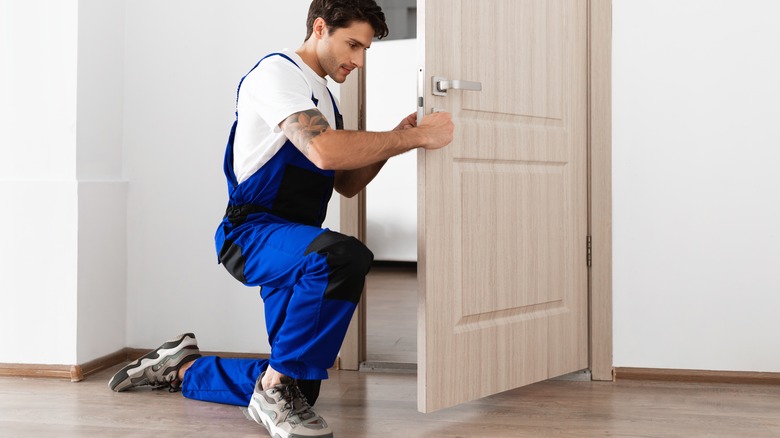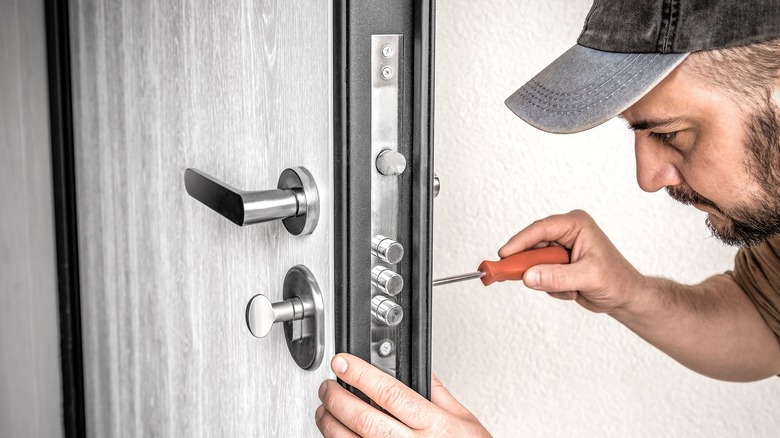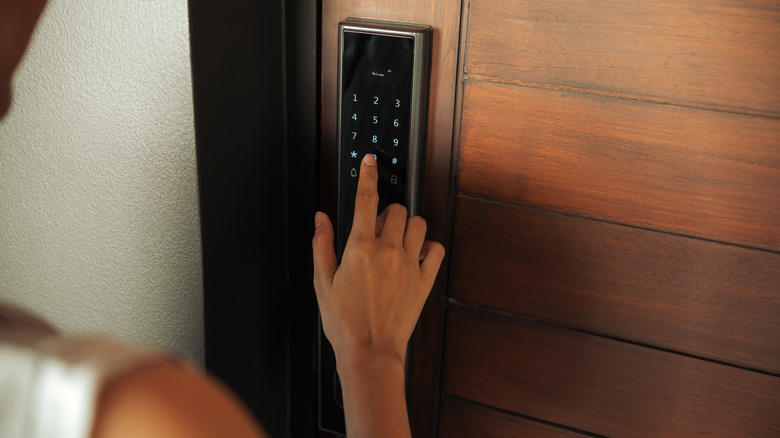This Simple Front Door Lock Upgrade Is The Key To A Safer Home
We may receive a commission on purchases made from links.
Whether you live in an apartment or house, we all take great care in protecting our homes. One of the easiest ways to do that is to invest in a quality lock that will keep intruders from entering our homes. However, burglars advance their techniques with the times, and some use more advanced methods than simply picking a lock. Keeping that in mind, not all locks are created to withstand these techniques, so to improve front door security, upgrade to a bump-proof lock.
Lock bumping isn't bumping into a door until it swings open. Instead, it's a little more tech-savvy than that. Lock bumping is when a burglar fashions a special key to open your door. To do so, they put the key into the cylinder lock and take a hammer or similar tool to lightly tap it. This forces the pins to fall into place around the bump key's grooves, which then allows them to open it. Locksmiths originally used this tool to open a wide variety of doors, but in the wrong hands, it can lead to burglary without any signs of forced entry. To protect yourself from this technique, replace the locks on your doors with bump-proof ones.
What's a bump-proof lock?
Bump-proof locks, or high-security locks, remove bumping from the equation because they don't rely on pins to open the door. This renders the intruder's bumping key useless. You will know a lock is bump-proof if it comes with a "UL 437" rating. This means it has passed a series of rigorous tests that not only make it bump-resistant, but will make it difficult to compromise in a multitude of different ways, like prying, drilling, or sawing. The standards were set by the Builders Hardware Manufacturing Association, which is the official association for commercial hardware in the U.S. You usually find these locks on government buildings, commercial skyrises, and banks, so you can be rest assured your house will be pretty hard to break into with one of these on your front door.
To choose one that's best for your home, you can either buy one at a local hardware store or first consult with a locksmith to see which one would best fit your situation and budget. Since they're so heavy-duty, there is a higher price tag involved in order to acquire one. For example, the Schlage CL-Series from Lock & Hinge is $160, while the Medeco Deadbolt is $236.
Other bump-proof locks to consider
You can also get quite high-tech with your bump-proof locks. If you really want to take out any possibility of lockpicking, get a lock without any type of cylinder. That means investing in a keyless door lock, or an electronic lock. These either require you to punch in a code on a pin pad, use a touchscreen, or use your fingerprint. While these are bump-proof, the jury is still out on whether or not they're safer than regular, high-security locks.
Those in favor of electronic locks point to the fact these devices come with several layers of security — such as 128-bit encryption, login credentials, and even PIN authentication codes — so they're very difficult to hack. However, those who are opposed to the tech point to the fact they can technically be hacked if the intruders get on your home's Wi-Fi or the device's Bluetooth. However, most burglars aren't that tech-savvy. They want to get into your house using the easiest means possible, which is why they use techniques such as bump keys, lockpicking kits, or crowbars. Having an electronic lock will most likely deter them from trying to break in. If you're interested in getting such a lock, the Schlage Encode Smart Wi-Fi Deadbolt ($299) and August Wi-Fi Smart Lock ($218) are great picks.


